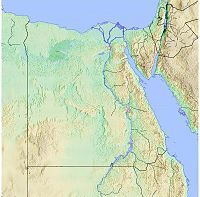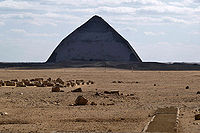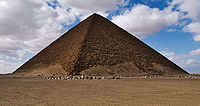- Dahshur
-
Memphis and its Necropolis - the Pyramid Fields from Giza to Dahshur * UNESCO World Heritage SiteCountry Egypt Type Cultural Criteria i, iii, vi Reference 86 Region ** Arab States Inscription history Inscription 1979 (3rd Session) * Name as inscribed on World Heritage List
** Region as classified by UNESCODahshur (Arabic دهشور Dahšūr, in English often called Dashur), is a royal necropolis located in the desert on the west bank of the Nile approximately 40 kilometres south of Cairo. It is known chiefly for several pyramids, two of which are among the oldest, largest and best preserved in Egypt, built from 2613-2589 BCE.
Contents
Pyramids
The Bent Pyramid and the Red Pyramid were constructed during the reign of Pharaoh Snofru (2613-2589 BCE), father of Khufu of the Old Kingdom. The shape of the Bent Pyramid is unique; it represents a transitional pyramid form believed to have been the result of an engineering crisis encountered during its construction. The Red Pyramid is the world's first true smooth-sided pyramid.
The pyramid of the 12th Dynasty king Amenemhat II (1929-1895 BCE) is now badly damaged. Next to it were found several undisturbed tombs of royal women still containing a large amount of jewellery. The pyramid of Sesostris III was part of a huge complex, with several smaller pyramids of royal women, along with another pyramid to the south. In a gallery tomb next to this pyramid were found two treasures of the king's daughters (Sithathor).
The Black Pyramid dates from the later reign of Amenemhat III and, although badly eroded, it remains the most imposing monument at the site after the two Snofru pyramids. The polished granite pyramidion or capstone of the Black Pyramid is on display in the main hall of the Egyptian Museum in Cairo. Next to the pyramid was found the partly disturbed tomb of 13th Dynasty king Hor and the undisturbed burial place of Nubhetepti-khered, possibly his daughter.
Several other pyramids of the 13th Dynasty were built at Dahshur. Only the one of the reign of Ameny Qemau has been excavated so far. Ahmad Fakhri was an archaeologist who worked at this site.
Extensive cemeteries of officials of the Old Kingdom and Middle Kingdom have been found around Dahshur's pyramids. Dahshur was Egypt's royal necropolis during the reign of the 12th Dynasty king Amenemhat II.
See also
- List of Egyptian pyramids
- List of megalithic sites
External links
References
Coordinates: 29°48′N 31°14′E / 29.80°N 31.24°E
World Heritage Sites in Egypt Abu Mena · Islamic Cairo · Memphis and its Necropolis – the Pyramid Fields from Giza to Dahshur · Nubian Monuments from Abu Simbel to Philae · Saint Catherine Area · Ancient Thebes with its Necropolis · Wadi Al-Hitan (Whale Valley)
Ancient Egypt Outline · Index
Architecture · Art · Burial customs · Chronology · Cuisine · Dynasties · Geography · History · Literature · Mathematics · Medicine · Military · Music · Religion · Pharaohs (list) · People · Language · Sites · Technology · Writing
Egyptology · Egyptologists · Egyptian MuseumPortal · List of major topicsCategories:- World Heritage Sites in Egypt
- Memphis, Egypt
- Archaeological sites in Egypt
Wikimedia Foundation. 2010.




